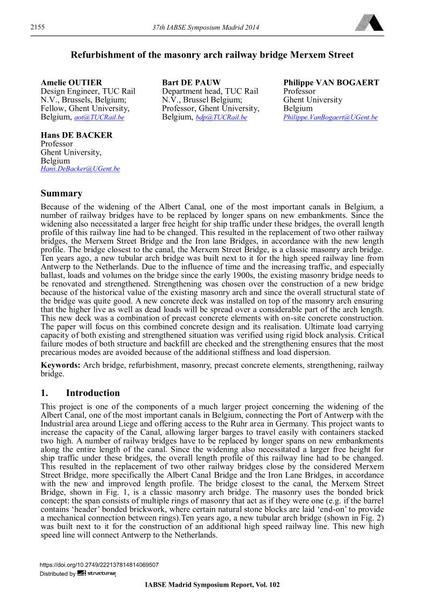Refurbishment of the masonry arch railway bridge Merxem Street

|
|
|||||||||||
Bibliographic Details
| Author(s): |
Amelie Outier
Bart De Pauw Philippe Van Bogaert Hans De Backer |
||||
|---|---|---|---|---|---|
| Medium: | conference paper | ||||
| Language(s): | English | ||||
| Conference: | IABSE Symposium: Engineering for Progress, Nature and People, Madrid, Spain, 3-5 September 2014 | ||||
| Published in: | IABSE Symposium Madrid 2014 | ||||
|
|||||
| Page(s): | 2155-2162 | ||||
| Total no. of pages: | 8 | ||||
| Year: | 2014 | ||||
| DOI: | 10.2749/222137814814069507 | ||||
| Abstract: |
Because of the widening of the Albert Canal, one of the most important canals in Belgium, a number of railway bridges have to be replaced by longer spans on new embankments. Since the widening also necessitated a larger free height for ship traffic under these bridges, the overall length profile of this railway line had to be changed. This resulted in the replacement of two other railway bridges, the Merxem Street Bridge and the Iron lane Bridges, in accordance with the new length profile. The bridge closest to the canal, the Merxem Street Bridge, is a classic masonry arch bridge. Ten years ago, a new tubular arch bridge was built next to it for the high speed railway line from Antwerp to the Netherlands. Due to the influence of time and the increasing traffic, and especially ballast, loads and volumes on the bridge since the early 1900s, the existing masonry bridge needs to be renovated and strengthened. Strengthening was chosen over the construction of a new bridge because of the historical value of the existing masonry arch and since the overall structural state of the bridge was quite good. A new concrete deck was installed on top of the masonry arch ensuring that the higher live as well as dead loads will be spread over a considerable part of the arch length. This new deck was a combination of precast concrete elements with on-site concrete construction. The paper will focus on this combined concrete design and its realisation. Ultimate load carrying capacity of both existing and strengthened situation was verified using rigid block analysis. Critical failure modes of both structure and backfill are checked and the strengthening ensures that the most precarious modes are avoided because of the additional stiffness and load dispersion. |
||||
| Keywords: |
refurbishment arch bridge masonry railroad bridge rail bridge strengthening precast concrete elements
|
||||
